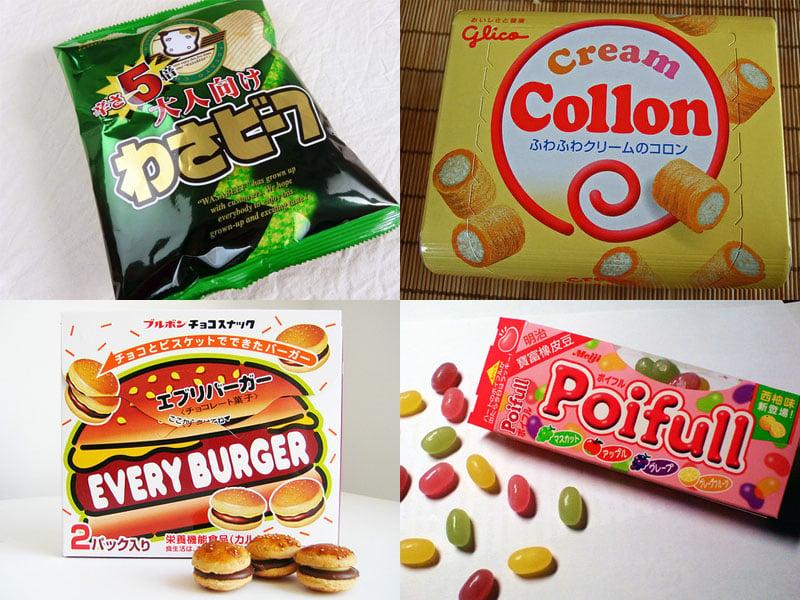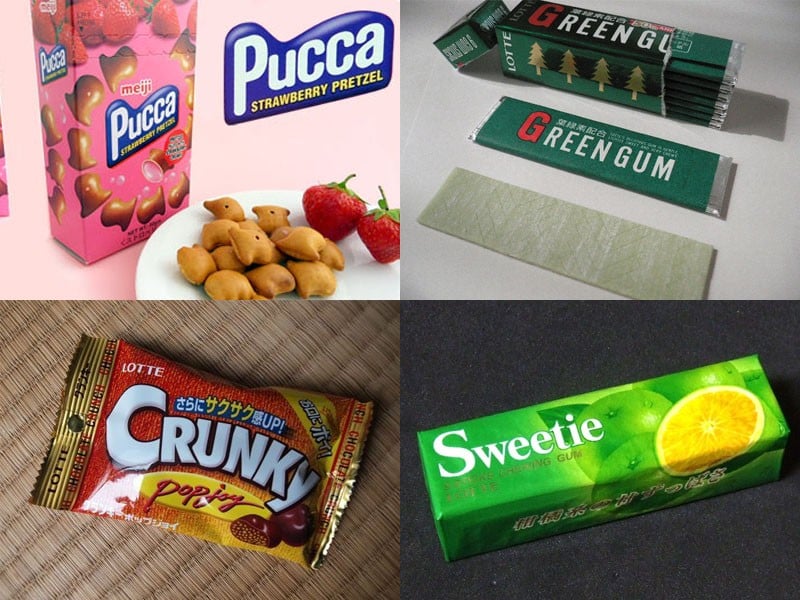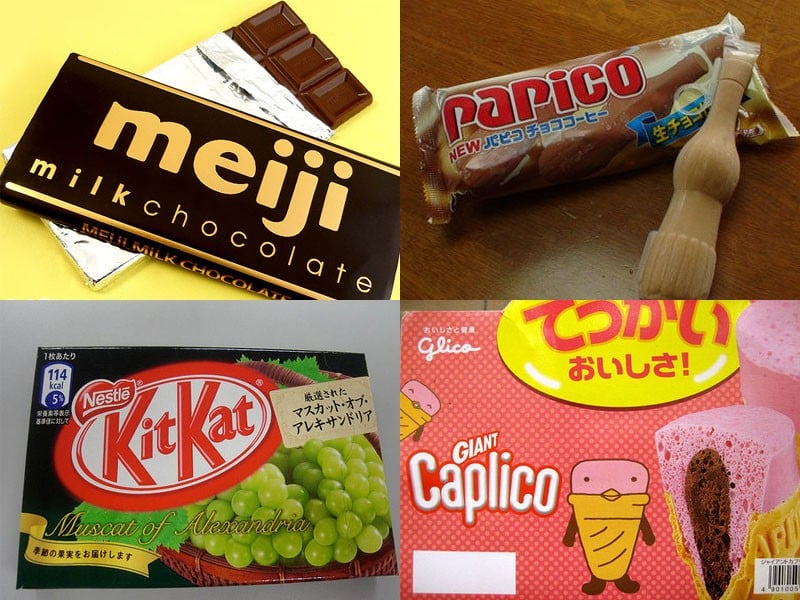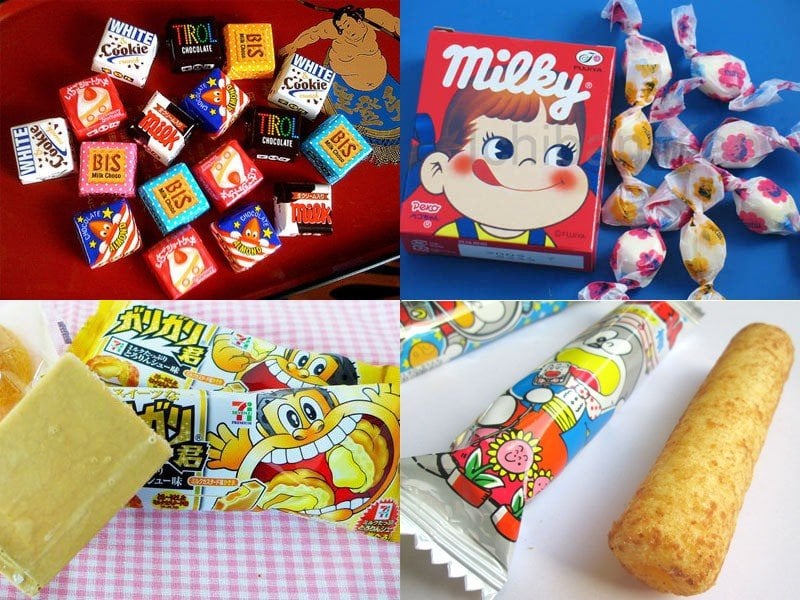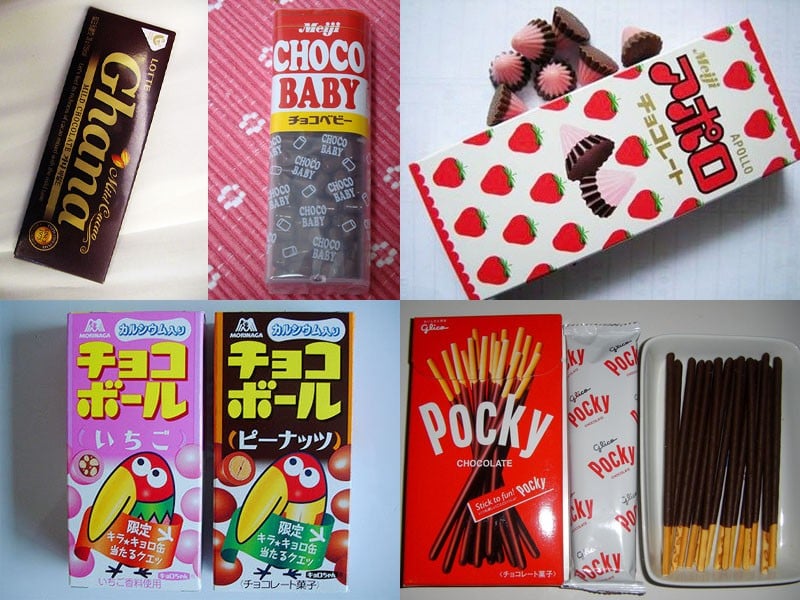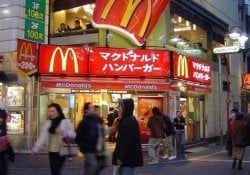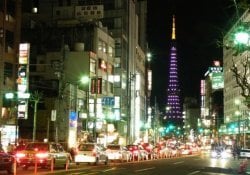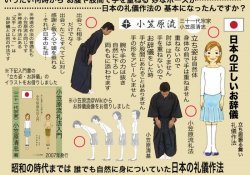In this article, we are going to look at some Japanese sweets and different ways to pronounce sweet and sweet in the Japanese language. Let's also get to know some popular Japanese snacks and sweets dagashi, and a complete list of sweets in Japanese.
Índice de Conteúdo
Famous Japanese sweets and their flavors
Everyone knows that Japan is full of sweets and snacks of countless different flavors and varieties. Several flavors and limited editions are created almost daily. Some sweets have been hugely successful, and have survived among these thousands of tasty inventions. In this article we will see the main sweets known in Japan.
Most of the Japanese snacks and sweets below fall into the category dagashi [駄菓子] which literally means cheap candy that can be found in small candy stores or convenience stores.
- Wasabeef - わさビーフ - Wasabi and meat flavored potato;
- Collon cream – A cookie stuffed with cream, and with that strange name...;
- Every Burger – Chocolate chip cookies that look like small hamburgers;
- rich - Jujubes with fruit flavor;
- Pucca – Cookies with a chocolate filling in the shape of a fish;
- Green Gum - The name says it all, green gum;
- Crunky Popjoy - Chocolate stuffed with crispy rice;
- Sweetie Gum - Uma bala querida..;
- Chelsea - Clássicas balas de caramelos duras;
- Kani Pan - Crab-shaped bread;
- Dars - chocolate quadrados;
- Kinoko no Yama - Mushroom Mountain Literally "mushroom mountain", a delicious biscuit covered in chocolate;
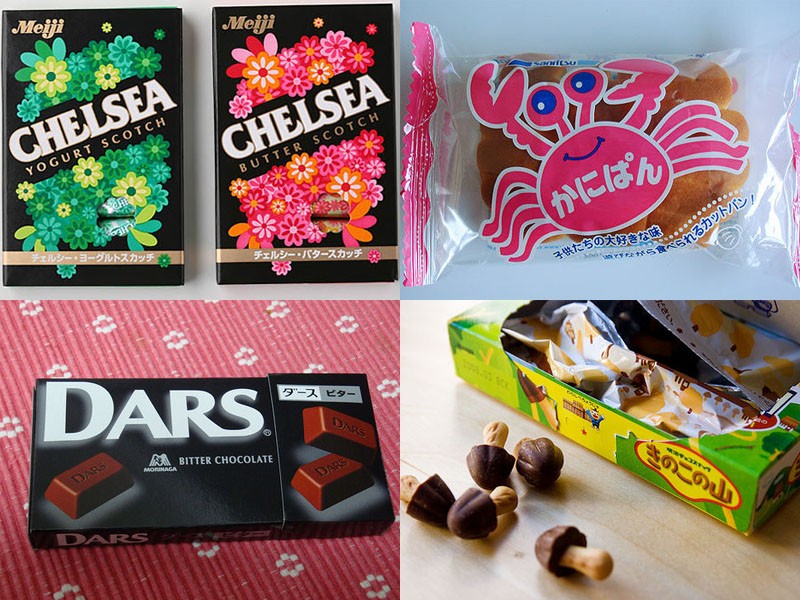
- Jagariko São batatas aromatizadas com queijo e vegetais;
- Chokobi - Chocolate em forma de estrela do anime Shin-chan;
- Hi Chew - Doce mastigavel com sabor de fruta;
- Koalas March - Koala Biscuits with various fillings;

- Pinky - Small spicy candies;
- Baby Star Ramen Salgadinhos em forma de macarrão;
- Bisuko - Classic Japanese biscuit;
- Tohato Caramel Corn - Salgadinho de milho caramelizado;
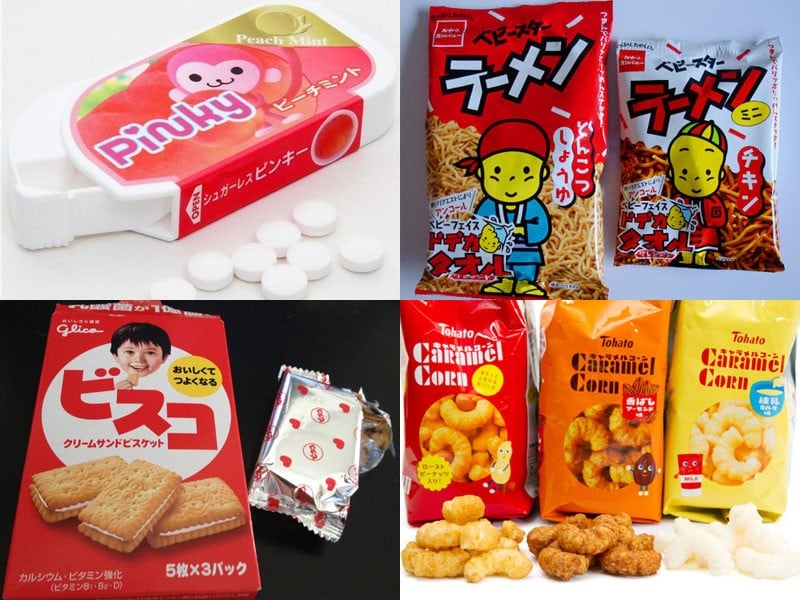
- Meiji Chocolate - A famous chocolate;
- papic – A bottle-shaped ice cream that tastes like a milkshake;
- Kitkat - Kit kat is successful in Japan. (See about kit kat flavors by clicking here.)
- Caplico - Fake cone ice cream;
- Tiroru – They are classic chocolate squares, they have dozens of flavors and seasonal varieties;
- milky - Milk candies and flavored caramel;
- Gari Gari Kun - A famous brand of ice cream with many different flavors;
- Umaibo – A different type of snack with different flavors;
- Ghana Chocolate - Marca Popular do chocolate ligeiramente escuro;
- Choco Baby - Pequenas balinhas feitas de chocolate;
- Apollo – Chocolate that mixes strawberry and milk with chocolate in the shape of a space capsule;
- Cuttlefish Ball – Chocolate with crunchy, strawberry or peanut filling;
- Pocky – They are sticks covered in chocolate. Very popular in Japan;
Did you like our short list of dagashi japanese sweets?
Different ways to say Candy in Japan
In the Japanese language there are many words that have or refer to the same meaning in English and vice versa. Let's examine the different ways of saying "sweet" in Japanese and also the name of some categories and sweets in general.
| Kanji | Kana | Romaji | Meaning / Notes |
| 甘い | あまい | love | It means Sweet, and can refer to the sweet taste. |
|
甜
| あま | Love | It also means sweet, but it is no longer used, only in Chinese. |
| キャンディ | Kyandi | An Americanized version of candy written in katakana. | |
| 飴 | あめ | Ame | Specifically it means candy, or candy of the kind. |
| 飴玉 | あめだま | Amedama | Candy in general, specifically jellybeans or round candies |
| お菓子 | おかし | Sweets | Sweets made in confectionery or confectionery / Or confectionery and confectionery |
| 乾菓子 | ひがし | Higashi | Dried sweets made in confectioneries |
| 有平糖 | アルヘイとう、ありへいとう | Aruheitō | Bonbons or candies made from sugar or caramel |
| 砂糖菓子 | さとうがし | Satō kashi | Confectionery products and sweets or sugar (or confectionery) |
| 金平糖 | こんぺいとう | Kompeitō | It is a type of candy or Japanese confection of Portuguese origin. |
| 糖菓 | とうか | Touka | Sweets, treats / Confectionery |
| 綿飴 | わたあめ | Wata love | Cotton Candy |
| 駄菓子 | だはし | Dagashi | cheap candy |
| チョコレート | Chokoreeto | Chocolate | |
| 飴細工 | あめざいく | Amezaiku | handmade candy |
| グミ | gummi | Gum | |
| 餅 | もち | Mochi | sweet made from rice |
| 糖蜜 | とうみつ | Tōmitsu | molasses |
| 和菓子 | わがし | Wagashi | Japanese traditional confectionery/traditional sweets |
| ガム | Gamu | Gum | |
| ロリポップ | Roripoppu | Lollipop (origin of English lollipop) |
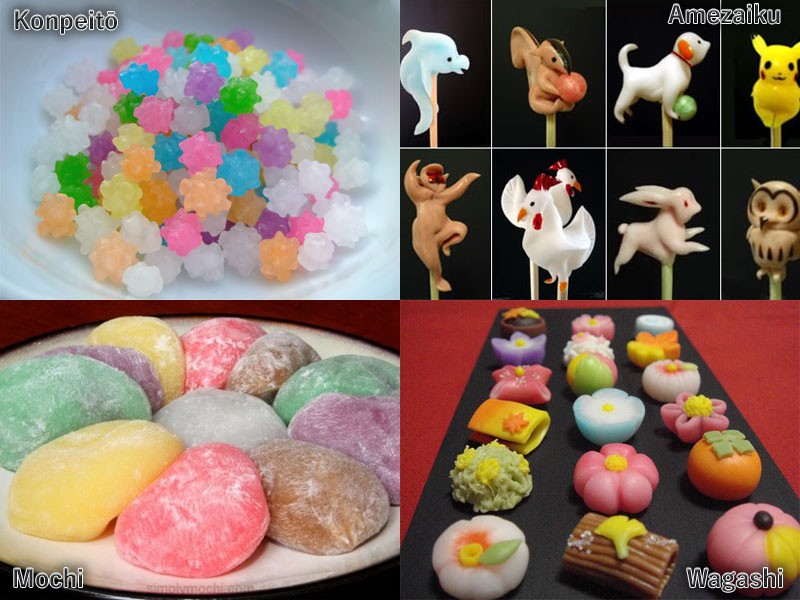
List of sweets in Japanese
Now let's share a list of sweets in Japanese. They are very popular sweets abroad, in the West, in the United States and in Japan. We will also leave the name of the candy in English to help identify them.
Let's learn the meaning, way of writing and translation of various sweets, cakes, chocolates, ice cream and others. The list doesn't have that many japanese traditional sweets, these are western sweets, most often written in katakana.
| Portuguese | English | Japanese | Romaji |
| sour (tablets) | tart | タルト | taruto |
| sweet potato | batata doce | スイートポテト | suītopoteto |
| baumkuchen | baumkuchen | バームクーヘン | bāmukūhen |
| bavaroa | bavaroa | ババロア | babaroa |
| cookie | shortcake | ショートケーキ | shōtokēki |
| Scone | muffin | マフィン | mafin |
| Scone | cupcake | カップケーキ | kappukēki |
| fruit cake | fruit cake | フルーツケーキ | furūtsukēki |
| pound cake | bolo de libra | パウンドケーキ | paundokēki |
| cheese cake | cheesecake | チーズケーキ | cheesecake |
| Marble cake | bolo marmorizado | マーブルケーキ | māburukēki |
| cream bomb | cream puff | シュークリーム | shūkurīmu |
| chocolate candy | chocolate bonbon | ボンボンショコラ | bonbonshokora |
| brigadeiro | trufa | トリュフ | toryufu |
| chocolate shell | chocolate shell | シェルチョコレート | sheruchokorēto |
| chocolate green tea | chocolate de chá verde | 抹茶チョコレート | matcha chocolate |
| whip | whip | ホイップ | hoippu |
| bitter chocolate | bitter chocolate | ビターチョコレート | bitachokoreto |
| milk chocolate | chocolate ao leite | ミルクチョコレート | miruku chokoretto |
| White Chocolate | chocolate branco | ホワイトチョコレート | howaitochokorēto |
| almond chocolate | chocolate de amêndoas | アーモンドチョコレート | āmondochokorēto |
| blueberry chocolate | blueberry chocolate | ブルーベリーチョコレート | burūberīchokorēto |
| sweet chocolate | chocolate doce | スイートチョコレート | suītochokorēto |
| dark chocolate | chocolate amargo | ダークチョコレート | dākuchokorēto |
| strawberry chocolate | Morango chocolate | ストロベリーチョコレート | sutoroberīchokorēto |
| pistachio chocolate | chocolate pistachio | ピスタチオチョコレート | pisutachio chocolate |
| dark chocolate | chocolate preto | ブラックチョコレート | burakkuchokorēto |
| churro | churro | チュロス | churosu |
| confetti | confetti | コンフェッティ | konfetti |
| chocolate cream | chocolate cream | クリームチョコレート | kurīmuchokorēto |
| creamy | cremoso | クリーミー | kurīmī |
| crepe mill | thousand crape | ミルクレープ | mirukurēpu |
| dragee | dragee | ドラジェ | doraje |
| eclair | eclair | エクレア | ekurea |
| ganache | ganache | ガナッシュ | ganasshu |
| gateau au chocolate | gateau au chocolate | ガトーショコラ | gatōshokora |
| jam | jelly | ゼリー | zerī |
| brown grace | brown grace | マロングラッセ | marongurasse |
| orange | orangette | オランジェット | oranjet |
| chocolate macaron | macaron chocolate | チョコレートマカロン | chokorētomakaron |
| madeleine | madeleine | マドレーヌ | madorēnu |
| melty | melty | メルティー | meruī |
| millefeuille | millefeuille | ミルフィーユ | mirufīyu |
| mousse | mousse | ムース | mūsu |
| chocolate mousse | chocolate mousse | チョコレートムース | chokorētomūsu |
| ópera gateau | gateau opera | ガトーオペラ | gatōopera |
| panna cotta | panna cotta | パンナコッタ | pan'nakotta |
| Panna Cotta Chocolate | panna cotta chocolate | チョコレートパンナコッタ | chokorētopan'nakotta |
| pancake | panqueca | パンケーキ | pancake |
| chocolate parfait | chocolate parfait | チョコレートパフェ | chokolate puff |
| praline | praline | プラリネ | purarine |
| pudding | pudding | プリン | purin |
| chocolate pudding | chocolate pudding | チョコレートプリン | chokorētopurin |
| cream pudding | custard pudding | カスタードプリン | kasutādopurin |
| burned | brulee | ブリュレ | buryure |
| real | royal | ロイヤル | roiyaru |
| rich | rico | リッチ | ritchi |
| ricotta | ricotta | リコッタ | ricotta |
| cake roll | rocambole | ロールケーキ | rōrukēki |
| donuts | donuts | ドーナッツ | dōnattsu |
| sachertorte | sachertorte | ザッハトルテ | zahhatorute |
| Ice cream | ice cream | アイスクリーム | ice cream |
| chocolate ice cream | chocolate ice cream | チョコレートアイスクリーム | chocolate ice cream |
| souffle | souffle | スフレ | sufure |
| tapioca | crepe | クレープ | kurēpu |
| tartathan | tartathan | タルトタタン | tarutotatan |
| 30TP1 Pumpkin Soup | pumpkin pie | パンプキンパイ | panpukinpai |
| caramel pie | caramel tart | キャラメルタルト | kyaramerutaruto |
| chocolate pie | chocolate tart | チョコレートタルト | chokorētotaruto |
| raspberry pie | raspberry pie | ラズベリーパイ | razuberīpai |
| fruits pie | fruit tart | フルーツタルト | furūtsutaruto |
| Apple pie | apple pie | アップルパイ | appurupai |
| lemon meringue pie | torta de limão com merengue | レモンメレンゲパイ | remonmerengepai |
| waffle | waffle | ワッフル | waffle |
The article is still halfway through, but we recommend also reading:
Kanji used in Japanese sweets
There are thousands of sweets in Japanese, so it's not possible to mention them all. Most of them use certain kanji to form the word, ideograms that sometimes separately have no use or mean something different. Let's see a list of them:
| Kanji | Chinese reading "ON" | Japanese reading "KUN" | Meanings |
|
菓
| カ | Sweets, cakes and fruits, caramels | |
|
餦
| チョウ | あめ、 もち | sweets, confectionery |
| 餹 | トウ | あめ | sugar, sweetened, candies, candied sweets |
|
飴
| イ、 シ | あめ、 やしな.う | Sweets, rice pudding, jellies, candies |
|
甜
| テン | うま.い、 あま.い | Sweet |
| 甘 | カン | あま.い、 あま.える、 あま.やかす、 うま.い | sweet, sugary, coax, pamper, be content |
It is worth remembering that sometimes kanji and sweet words like [甘] are used to represent feelings, actions, personalities as well as the term “sweet in English”.
Where to buy Japanese Sweets?
There are many Asian grocery stores where you can buy common Japanese sweets like pocky and pepper. I personally recommend those boxes of random candy that are sent monthly to subscribers, shipping is free to Brazil and the cost benefit is higher.
I recommend to Japan Candy Box that can be accessed by clicking here!
Finally, see a showcase of Japanese sweets that you can buy in Brazil (on the websites you will find more Japanese sweets):
Well, this was a short article, with main objective to tell you the different shapes and categories of Japanese sweets to increase your vocabulary.
Hope you enjoyed this list of Japanese sweets! If you want to see others food in japanese, or traditional Japanese sweets like wagashi, just browse the cooking categories on the Suki Desu website.
Learn to make Traditional Japanese Wagashi Sweets
Before we close the article I want to recommend the Wagashi Traditional Japanese Confectionery Course. Below we will leave an interview from Jornal da Tarde about the author of the course Cesar Yukio and his beautiful and delicious recipes:
If you want to make delicious western sweets, Cesar also has the Yogashi Confectionery Course.
If you liked the article, don't forget to share and leave your comments.

